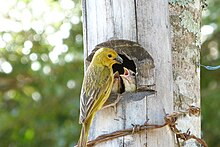Saffron finch
| Saffron finch | |
|---|---|

| |
| Male | |

| |
| Female | |
| Scientific classification | |
| Kingdom: | |
| Phylum: | |
| Class: | |
| Order: | |
| Family: | |
| Genus: | |
| Species: | S. flaveola
|
| Binomial name | |
| Sicalis flaveola (Linnaeus, 1766)
| |

In the Pantanal, Brazil
The saffron finch (Sicalis flaveola) is a tanager from South America that is common in open and semi-open areas in lowlands outside the Amazon Basin. They have a wide distribution in Colombia, northern Venezuela (where it is called "canario de tejado" or "roof canary"), western Ecuador, western Peru, eastern and southern Brazil (where it is called "canário da terra" or "native canary"), Bolivia, Paraguay, Uruguay, northern Argentina, and Trinidad and Tobago. It has also been introduced to Hawaii, Puerto Rico and elsewhere. Although commonly regarded as a canary, it is not related to the Atlantic canary. Formerly, it was placed in the Emberizidae but it is close to the seedeaters. The male is bright yellow with an orange crown which distinguishes it from most other yellow finches (the exception being the orange-fronted yellow finch). The females are more confusing and are usually just a slightly duller version of the male, but in the southern subspecies S. f. pelzelni they are olive-brown with heavy dark streaks.
Typically nesting in cavities, the saffron finch makes use of sites such as abandoned rufous hornero (Furnarius rufus) nests, bamboo branches and under house roofs - this species is tolerant of human proximity, appearing at suburban areas and frequenting bird tables. They have a pleasant but repetitious song which, combined with their appearance, has led to them being kept as caged birds in many areas. Males are polygamous, mating with two females during the nesting season, and territorial, which has led to the species being used for blood sporting with two males put in a cage in order to fight.[2]
References
- Betsy Trent Thomas, "Conoce nuestras aves", ISBN 980-257-032-X
Footnotes
- ^ Template:IUCN
- ^ Cf. José Felipe Monteiro Pereira, Aves e Pássaros comuns do Rio de Janeiro, Rio de Janeiro, Technical Books, 2008, ISBN 978-85-61368-00-5 , page 134
External links
- Saffron Finch videos, photos & sounds on the Internet Bird Collection
- Stamps (for Argentina, Brazil, Suriname)
- Saffron Finch photo gallery VIREO
- Saffron Finch Species Profile
- IUCN Red List least concern species
- Sicalis
- Birds of Panama
- Birds of South America
- Birds of the Caatinga
- Birds of the Pantanal
- Birds of the Cerrado
- Birds of Aruba
- Birds of the Netherlands Antilles
- Birds of Trinidad and Tobago
- Birds of the Cayman Islands
- Birds of Peru
- Birds of Puerto Rico
- Birds of Cuba
- Birds of Jamaica


